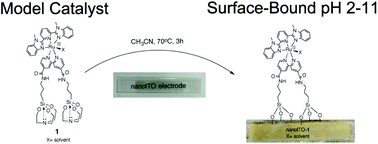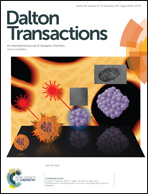Silatranes for binding inorganic complexes to metal oxide surfaces†
Abstract
A ruthenium complex containing silatrane functional groups has been synthesized and covalently bound to a conductive metal oxide film composed of nanoparticulate ITO (nanoITO). The silatrane-derived siloxane surface anchors were found to be stable in the examined range of pH 2 to 11 in aqueous phosphate buffer, and the ruthenium complex was found to have stable electrochemical features with repeated electrochemical cycling. The non-coordinating properties of the silatrane group to metals, which facilitates synthesis of silatrane-labeled coordination complexes, together with the facile surface-binding procedure, robustness of the surface linkages, and stability of the electrochemical properties suggest that incorporating silatrane motifs into ligands for inorganic complexes provides superior properties for attachment of catalysts to metal oxide surfaces under aqueous conditions.


 Please wait while we load your content...
Please wait while we load your content...